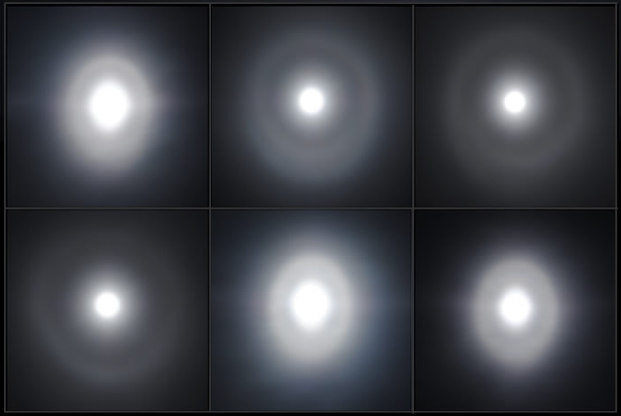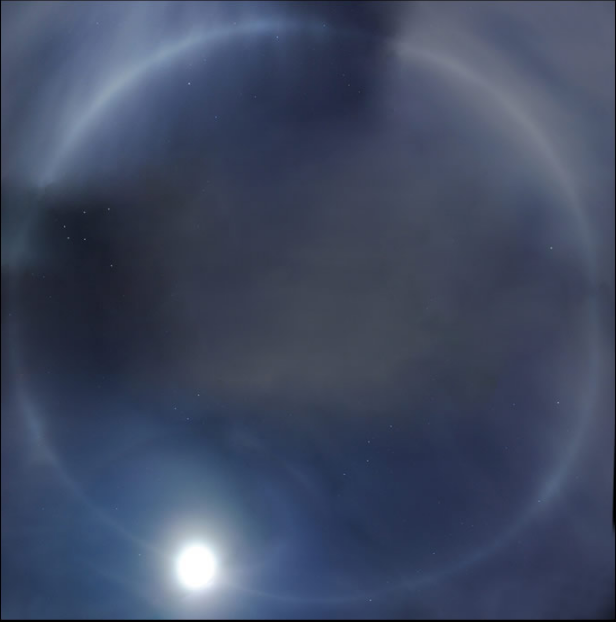OPOD - Lunar elliptical halos plus
OPOD - Lunar Elliptical Halos Plus: A Fascinating Atmospheric Phenomenon Explored
Have you ever gazed at the night sky and noticed peculiar shapes surrounding the moon or sun? These mesmerizing optical phenomena are known as elliptical halos. In a recent capture by Adam Kraft in Spring Arbor, Michigan, rare elliptical halos and a complete paraselenic circle were observed, adding to the allure of these atmospheric wonders.
The Enigmatic Elliptical Halos
Elliptical halos are small, spanning only a few degrees across the sky. What sets them apart is their distinctive "ovality," with some displaying a single ring and others showcasing multiple rings. These ethereal formations do not necessarily align perfectly with the moon or sun, giving them an unpredictable and captivating nature.
Adam Kraft's lunar halo presented an intriguing spectacle as it underwent changes in size and form over a span of two hours. In the images captured, we can observe the evolution of the halo's shape, with the moon positioned at 51.5 degrees above the horizon. The measurements revealed that the halo stretched 4.7 by 3.8 degrees, showcasing its elliptical nature.
Unraveling the Mystery Behind Elliptical Halos
The formation of elliptical halos can be attributed to the passage of light rays through pyramidal ice crystals. These crystals possess an exceptionally "flat" structure, resembling prisms that create a refraction effect over a limited range. As a result, the light rays diverge and form a variety of oval shapes in the sky.
To gain further insights into these enigmatic halos, scientists employ HaloSim ray tracings to simulate different scenarios. By adjusting various parameters and incorporating different crystal types, they can attempt to recreate observed halos. However, achieving a perfect match remains a challenging task due to the inherent complexity of the phenomenon.
Exploring Crystallographic Theory and Ice Forms
While the prevailing explanation for elliptical halos revolves around pyramidal ice crystals, there are intriguing deviations from crystallographic theory. The required pyramidal angles defy conventional crystallographic principles, prompting researchers to consider alternative ice forms that could be responsible for these captivating optical displays. Dendritic snowflakes, with their intricate and branching structures, present a compelling avenue for further investigation.
The Alluring Paraselenic Circle
In addition to the elliptical halos, Adam Kraft's observations unveiled another captivating atmospheric phenomenon known as a paraselenic circle. This awe-inspiring arc curves through the moon, forming a complete circle that adds to the visual spectacle. By stitching together eight images, Kraft masterfully captured the intense paraselenic circle, highlighting its prominence in the night sky.
A World of Atmospheric Optics
The realm of atmospheric optics is a treasure trove of extraordinary phenomena that continue to astound and perplex scientists and observers alike. From the intricate patterns of elliptical halos to the alluring paraselenic circles, each discovery unveils a new layer of complexity and beauty in our atmosphere.
As we delve deeper into the mysteries of atmospheric optics, we gain a better understanding of the intricate interplay between light, particles, and atmospheric conditions. While we may not have all the answers yet, the exploration of these captivating phenomena sparks curiosity and fuels scientific inquiry.
Conclusion
The mesmerizing world of atmospheric optics never fails to amaze us with its captivating displays. The recent capture of rare elliptical halos and a complete paraselenic circle by Adam Kraft in Spring Arbor, Michigan, serves as a testament to the awe-inspiring beauty that graces our skies. As scientists continue to unravel the secrets behind these optical phenomena, we are left with a sense of wonder and a desire to explore further into the mysteries of our atmosphere.
Ellipses & Circles
Rare elliptical halos and a complete paraselenic circle (below) captured by Adam Kraft on the night of 7/8 February at Spring Arbor, Michigan.
All images ©Adam Kraft, shown with permission

Elliptical halos are small, a few degrees across and of varying �ovality�. Some have one ring while others sport several and not necessary centred on the moon or sun making them.
Adam�s lunar halo varied in size and form over two hours as the samples at middle left show. The moon was 51.5 degrees high In the top image and the halo measured 4.7 by 3.8�.
The arc curving through the moon is a paraselenic circle - see the lowest image.
Elliptical halos might be made by rays passing through very �flat� pyramidal ice crystals. These would effectively form prisms of just a few degrees and enough to produce the necessary small extent of refraction.
Several ray paths are possible and give a variety of ovals. At lower left HaloSim ray tracings simulate several halos for a moon 51.5� high. Their variety comes from small variations in relative sizes of crystal facets and pyramidal angles. Extensive parameter adjustment and use of more than one crystal type could start to match a particular observed halo. But the match is rarely perfect and it is an unfruitful exercise that we learn little from.
There is a deeper issue. The required pyramidal angles are very unphysical, counter to crystallographic theory. Other ice forms like dendritic snowflakes might be responsible.
An elliptical mystery.




The sky was also rich with column crystals giving an occasional circumscribed halo and this intense paraselenic circle. Adam Kraft stitched together eight images to show it.
Note: this article has been automatically converted from the old site and may not appear as intended. You can find the original article here.
Reference Atmospheric Optics
If you use any of the definitions, information, or data presented on Atmospheric Optics, please copy the link or reference below to properly credit us as the reference source. Thank you!
-
<a href="https://atoptics.co.uk/blog/opod-lunar-elliptical-halos-plus/">OPOD - Lunar elliptical halos plus</a>
-
"OPOD - Lunar elliptical halos plus". Atmospheric Optics. Accessed on November 22, 2024. https://atoptics.co.uk/blog/opod-lunar-elliptical-halos-plus/.
-
"OPOD - Lunar elliptical halos plus". Atmospheric Optics, https://atoptics.co.uk/blog/opod-lunar-elliptical-halos-plus/. Accessed 22 November, 2024
-
OPOD - Lunar elliptical halos plus. Atmospheric Optics. Retrieved from https://atoptics.co.uk/blog/opod-lunar-elliptical-halos-plus/.